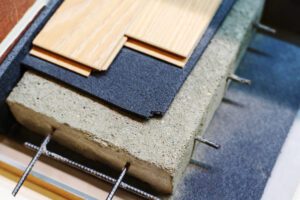How to Choose the Right Floor Insulation for Your Home

<?xml encoding=”utf-8″ ?????????>
Floor insulation is particularly important, as it helps reduce heat loss and enhances the overall energy efficiency of your home. In this post, we will discuss how to choose the right floor insulation for your home.
Types of Floor Insulation
There are several types of floor insulation available, each with its pros and cons. The most common types of floor insulation include:
Fibreglass insulation: As one of the most common types of insulation, this is relatively inexpensive. Fibreglass insulation is really easy to install and can be used in various applications. However, it is not the most effective type of insulation and can be prone to moisture problems.
Cellulose insulation: This insulation is crafted from recycled paper and is an eco-friendly option. It is more effective than fibreglass insulation and can be used in various applications. However, it can be more expensive than fibreglass insulation.
Spray foam insulation: This is a more expensive option but is also the most effective. It is particularly useful for insulating hard-to-reach areas and can help to reduce air leakage. However, it can be challenging to install and prone to moisture problems.
Reflective insulation: This type of insulation reflects heat back into the room. It is particularly useful for homes in hot climates and can help to reduce cooling costs. However, it is not effective in cold climates.
Factors to Consider When Choosing Floor Insulation
When choosing floor insulation, there are several factors that you should consider. These include:
Climate: Your area’s climate plays a significant role in determining the type of insulation that you need. For example, if you live in a cold climate, you will need insulation that effectively reduces heat loss.
Budget: The insulation cost can vary significantly depending on the type of insulation you choose. You should consider your budget when choosing insulation.
Type of flooring: The type of flooring that you have will also play a role in determining the type of insulation that you need. For example, if you have a concrete floor, you will need insulation suitable for use with concrete.
Location of the insulation: It is important to consider where the insulation will be installed. For example, if the insulation is installed in a crawl space, you will need insulation resistant to moisture.
How to Install Floor Insulation
Installing floor insulation is a relatively straightforward process. Here is a step-by-step guide:
Clean the floor: Before installing insulation, you should clean the floor to remove any debris.
Measure the area: Measure the area that you want to insulate to determine how much insulation you will need.
Cut the insulation: Cut the insulation to the appropriate size using a utility knife.
Lay the insulation: Lay the insulation on the floor, ensuring it fits snugly against the walls.
Seal the edges: Make sure to seal the edges of the insulation with tape to prevent air leakage.
Common Mistakes to Avoid
When installing floor insulation, there are several common mistakes that you should avoid. These include:
Neglecting to air seal: Insulation is not a barrier to air movement, and it is essential to air seal the area to prevent air leakage.
Choosing the wrong type of insulation: Choosing the wrong type of insulation can result in poor insulation and reduced energy efficiency.
Not considering the type of flooring: The type of flooring that you have will play a role in determining the type of insulation that you need.
Incorrectly measuring the area: Failing to measure the area correctly can result in not having enough insulation.
Forgetting to seal the edges: Failing to seal the edges of the insulation can result in air leakage.
Conclusion
In conclusion, choosing the right floor insulation is essential to ensure your home is energy-efficient and comfortable. When choosing insulation, you should consider factors such as climate, budget, and the type of flooring you have. You can ensure your home is insulated and energy-efficient by avoiding common mistakes and following the installation process correctly. Remember, insulating your home from the roof down to its foundation is important for optimal energy efficiency. Furthermore, if you are looking for home insulation solutions, you can always rely on buildersinsulation.co.uk for quality insulation.
FAQs
What areas of my home should be insulated?
It is crucial to guarantee proper insulation of your home from the roof down to its foundation to attain the highest level of energy efficiency. This includes the attic, walls, floors, and foundation walls above ground level.
What should I consider when choosing insulation?
When choosing insulation, you should consider factors such as climate, budget, type of flooring, and location of the insulation.
What is the best type of insulation for floors?
The best type of insulation for floors depends on several factors, including the type of flooring, climate, and budget. Fibreglass, cellulose, spray foam, and reflective insulation are all common types of insulation for floors.




